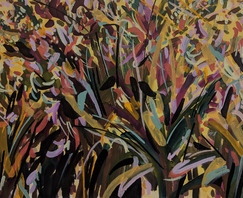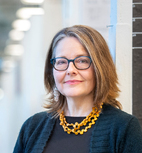
Academics . Painting . Courses
Painting Courses
Painting: Color, Scale, Mark + Form
Course No. PTG 241 Credits: 3.0
âFigurative,â âabstract,â âconceptual,â ânon-objective,â âromantic landscape,â âpost-modern,â âBob Ross-ianâ â"paintings all have an underlying structure. This studio course examines how the specificity of color, scale, mark and shape form and affect a paintingâs content. Students will be encouraged to focus on their own body of work while exploring issues of content within the themes of the class through the investigation of their own studio practice, and by looking at and analyzing the work of other painters and artists throughout history. This course will be of particular interest to students in Painting, Drawing, & Printmaking. This course is open to all students with the prerequisite of PTG 221 or PTG 232 or with the permission of the instructor. 3 credits.
On Painters + Painting: Aura, Author
Course No. PTG 251 Credits: 3.0
With an emphasis on the practice of Painting, this class examines the role subjectivity plays in contemporary art. The position of the artist and the frame of the canvas will be traced from the modernist notion of individual expressiveness, to postmodernist practices characterized by the end of the authorâs authority and finally to contemporary practices in which the artistâs hand reemerges in dialogue with mechanized and digital processes. Students will be asked to grapple with these complex issues in relationship to what they paint and how they paint. Class discussions will address a variety of critical essays dealing with these topics and the practice of painting as treated by artists and critics. This course is open to all students with the prerequisite of PTG 221 or PTG 232 or with the permission of the instructor. 3 credits.
Hybrid Approaches Drawing & Painting: Digital Media
Course No. PTG 327H Credits: 3.0
Emphasis is on integrating digital processes into studio practice and production. The class deals with a spectrum of digital applications in a studio practice including straight forward digital output, using digital as a means of producing source material as well as actually integrating digital processes into the production of work. Through slide presentations, viewing actual work, discussions and readings, students will be introduced to the place of the digital in contemporary studio practice. In studio production, students will use varied media and subjects, both traditional and non-traditional, to further develop their analytical and expressive means in their creative practice. Students are encouraged to draw from many disciplines incorporating them in the projects presented to the class for group critiques. Open to all students â" required of Printmaking and Drawing juniors. 3 credits.
Painting: Internship (EP)
Course No. PTG 399-499 Credits: 3.0
Students will submit a written proposal for a semesterâs long course of work. This work should have three primary components: a written paper, studio work, and work in the field (eg.: working for a gallery or artist). A timeline for the completion and review of these components are also required. The proposal must be sponsored by the supervising faculty meaning that the proposal must be vetted and accepted by the faculty who will oversee the project before it is submitted to the department head. This course is open to all Painting majors. 3 credits. Prerequisite: PTG221 Intro to Painting or PTG232 Painting Beyond Observation. Fulfills Engaged Practice requirement.
Senior Studio: BFA Research
Course No. PTG 421M Credits: 3.0
Required for all 4th year Painting majors and open as an elective to any senior-level student with a prerequisite of Intro to Painting, Painting Beyond Observation, or permission of the instructor or Painting Chair. This course focuses on developing the studentâs individual work as it relates to their subject and their means of making work. Emphasis will be on the strategies for constructing the meaning of the work in terms of materials and the way the work is read by a viewer. Students will read work, develop and discuss intention through critiques and discourse. The goal is to develop an understanding of the criteria, standards and values promoted by the artist and how these come to be understood by their audience by exploring the relationship between subject, form, material and process as they relate to content. Prerequisites: PTG 221. 3 credits.
Painting Seminar: Contemporary Issues in Painting
Course No. PTG 422M Credits: 3.0
In preparation for the studentâs final BFA defense and for working beyond an undergraduate level, this course focuses in an advanced manner on the seminal issues covered over the course of the studentâs visual arts education. Questions of style, aesthetics, concept, meaning, and context are addressed. Particular emphasis is given to issues concerned with presentation, âframing,â audience and reception. Students are expected to engage in critical discourse surrounding the work of fellow students, established artists and their own work. By the end of the term students are expected to have developed a professional body of work to be presented in their BFA Thesis Exhibition, continued to maintain and develop their studio practice, clearly identify the subject of their work, defend their choices in relation to this subject as well as discuss reasonable expectations of audience reception. Course readings will be given in relation to these topics as well as the maintenance of a professional studio practice. Required for all 4th year Painting majors and open as an elective to any senior or with the permission of the instructor or Painting Head. 3 credits.
Image + Form I
Course No. VAT 200 Credits: 3.0
Image/Form promotes a general understanding how images work and are developed, which is a fundamental aspect of the Visual Arts. The course introduces the students to the various means by which images can be rendered, such as by drawing, painting, carving, embroidering, etching, etc., as well as by digital means, by appropriation, and by the use of ready-mades. The students are also introduced to the diverse ways in which images and forms can be manipulated, or manifested conceptually and materially by exploring the inter-relation between 2 and 3 dimensions, as well as in time-based media by the use of collage or assemblage. In doing this, we introduce them to the concept that an imageâs âform,â consisting of its physical and spatial qualities, as well as the technical qualities of their chosen mode of production, is part of its content. By these means they are introduced to practical and semiotic nature of images and their production in the context of the contemporary by means of assignments, readings, discussions, and studio critiques. Open as elective to all majors. This course is required for all sophomore students in Visual Arts. 3 credits.
The Artistâs Practice in Context
Course No. VAT 200X-300X-400X Credits: 1.5
As a complement to the Professional Practices course, âThe Artistâs Practice in Contextâ is specifically designed for Visual Arts students. The course takes an intimate look at the professional practices of artists working in major metropolitan areas such as New York City, Chicago, Los Angeles or Berlin. As part of the course students examine the realities of maintaining a professional practice within the context of this focus community. Students, guided and directed by faculty, are immersed in that community through such activities as studio visits; meetings area arts professionals and art venues. Open to all. Students must be 18 years old or over and must sign a waiver to travel with the group. Course may be taken more than once for additional credit. 1.5 credits.
Meet Your Faculty view all
Lane Cooper
Professor | Chair, Painting
Lane Cooper is an artist who works through painting, sound, video, text and, on occasion, performance. Her wor...more
Featured Student Work view all

Our connections are your connections.
While at CIA, you'll learn from the masters through our rigorous, world-class curriculum and connect with working professionals to begin your career.

